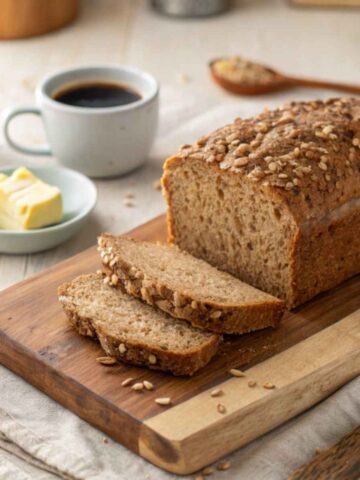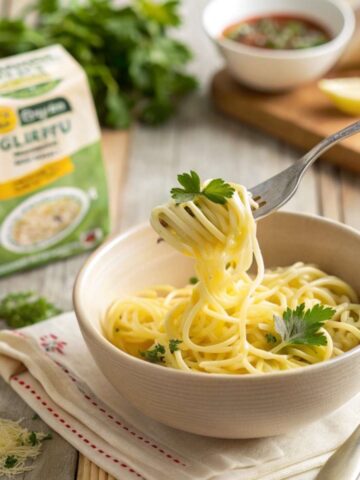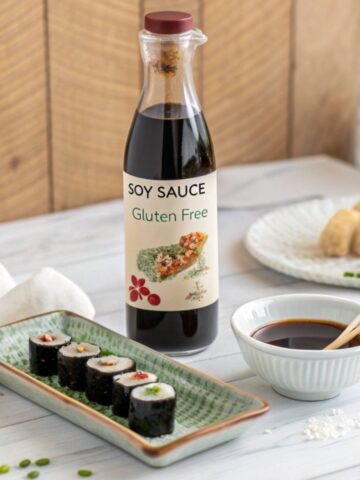Rice Krispies are a breakfast classic, beloved by many for their crunchy texture and snap, crackle, and pop sounds. But if you follow a gluten free diet, you might ask: Are Rice Krispies gluten free? With gluten intolerance and celiac disease becoming more recognized, ensuring your foods are safe is crucial.

This article will explore whether Rice Krispies are gluten free, available alternatives, and how you can enjoy your favorite cereal without worrying about gluten exposure.
Jump to:
- What is Gluten?
- What Are Rice Krispies?
- Are Rice Krispies GF?
- Why Regular Rice Krispies Are Not GF
- Rice Krispies: What Are the Options?
- How to Identify Gluten-Free Products
- GF Rice Krispies Alternatives
- How to Ensure Rice Krispies Treats are Gluten Free
- Are Rice Krispies Safe for People with Celiac Disease?
- Homemade Rice Krispies Treats
- Cross-Contamination Concerns in Gluten-Free Rice Krispies
- Rice Krispies and Cross-Reactivity with Other Grains
- Nutritional Value of Rice Krispies
- Conclusion
- FAQs
What is Gluten?
Gluten and Where It's Found
Gluten is a protein in certain grains, primarily wheat, barley, and rye. It helps give the dough its elasticity and contributes to the chewy texture of baked goods. Unfortunately, for individuals with gluten sensitivity or celiac disease, consuming gluten can lead to serious health issues.
Celiac disease is an autoimmune disorder in which gluten causes damage to the small intestine. For people with gluten sensitivity, eating gluten triggers symptoms like bloating, fatigue, and headaches but without the autoimmune response. Therefore, maintaining a gluten free diet is essential for those affected.
What Are Rice Krispies?
A Brief History of Rice Krispies
Rice Krispies were first introduced by Kellogg's in 1928. Over the years, they’ve become a breakfast staple and a key ingredient in Rice Krispies treats, making them one of the most versatile cereals on the market.
What Are Rice Krispies Made Of?
Traditional Rice Krispies are made from crisped rice, sugar, salt, and vitamins. However, the flavorings and additives can sometimes make them a questionable choice for those avoiding gluten.
Are Rice Krispies GF?
The Ingredients Breakdown
Rice Krispies might seem like a simple, rice-based cereal, so it’s natural to assume they’re gluten-free. But the truth is a bit more complex. While rice doesn’t contain gluten, other ingredients, like malt flavoring, can introduce gluten into the product.
Rice itself doesn’t contain gluten, but if you’re curious about white rice specifically, check out our guide on white rice gluten-free.
Kellogg’s Original Rice Krispies: Gluten-Free or Not?
Kellogg's Original Rice Krispies, which are the most widely available, are not gluten-free. The cereal contains malt flavoring derived from barley, a gluten-containing grain. This ingredient makes them ineligible to be considered gluten-free.
Cross-Contamination Concerns in Manufacturing
In addition to gluten-containing ingredients, cross-contamination during manufacturing is another issue to consider. Rice Krispies are often produced in facilities that handle wheat, which raises the risk of gluten exposure even in products that might not contain gluten ingredients.
Why Regular Rice Krispies Are Not GF
Malt Flavoring: The Gluten Culprit
The main reason why regular Rice Krispies are not gluten-free is the use of malt flavoring. Malt is derived from barley, which contains gluten. This means that even though the base of Rice Krispies is rice, they are not safe for people with gluten sensitivities or celiac disease.
Alternative Ingredients That Could Contain Gluten
Sometimes, cereal additives or preservatives contain gluten or are made in gluten-containing environments. Even for seemingly gluten-free products, it’s always a good idea to double-check the label.
Rice Krispies: What Are the Options?
Kellogg's Gluten-Free Rice Krispies (U.S. Market)
At one point, Kellogg’s offered a gluten-free version of Rice Krispies made with brown rice instead of malt flavoring. However, this version has been discontinued in many areas, leaving gluten-sensitive consumers searching for alternatives.
Alternative Brands Offering Gluten-Free Versions
Several other brands now offer gluten-free alternatives to Rice Krispies, ensuring you don’t miss out on your favorite cereal. These include Barbara’s Brown Rice Crisps, Erewhon Organic Gluten-Free Crispy Brown Rice Cereal, and Nature’s Path Crispy Rice.
How to Identify Gluten-Free Products
Understanding Gluten-Free Labeling
When shopping for gluten-free products, it’s essential to understand gluten-free labeling. In the U.S., the FDA mandates that products labeled "gluten-free" contain less than 20 parts per million (ppm) of gluten, a threshold generally safe for most people with gluten sensitivities.
How to Read Ingredient Labels Properly
When scanning the ingredients, look out for terms like "malt flavoring," "barley," or "wheat," which all indicate the presence of gluten. Products without these ingredients are more likely to be safe for a gluten-free diet.
GF Rice Krispies Alternatives
If you’re looking for a gluten-free cereal with the same crunch as Rice Krispies, here are a few excellent alternatives:
Barbara’s Brown Rice Crisps
Barbara’s Brown Rice Crisps are made from whole-grain brown rice and are certified gluten-free. They offer the same light and crispy texture as traditional Rice Krispies, making them a fantastic alternative for anyone avoiding gluten.
Erewhon Organic Gluten-Free Crispy Brown Rice Cereal
Erewhon Organic offers a gluten-free crispy brown rice cereal that is also organic and free from artificial flavors or preservatives. This cereal is a healthy, gluten-free option perfect for breakfast or for use in treat recipes.
Nature’s Path Crispy Rice
Nature’s Path is a famous organic brand that offers a gluten-free crispy rice cereal made with brown rice. This cereal is also non-GMO, making it a great choice for those with dietary restrictions.
How to Ensure Rice Krispies Treats are Gluten Free
Ingredients to Watch Out For
Making gluten-free Rice Krispies treats requires more than just choosing a gluten-free cereal. You’ll also need to ensure that the other ingredients, such as marshmallows and butter, are gluten-free. While most marshmallows are gluten-free, some may contain trace amounts of gluten from flavorings or additives.
Gluten-Free Marshmallows and Butter
Choose marshmallows and butter labeled as gluten-free to ensure that your Rice Krispies treats are 100% gluten-free. Many brands, including Jet-Puffed Marshmallows, offer gluten-free options, so always check the packaging.
Are Rice Krispies Safe for People with Celiac Disease?
Understanding the Risks
Unfortunately, regular Rice Krispies are not safe for individuals with celiac disease. The malt flavoring, derived from barley, is a source of gluten. Even trace amounts of gluten can cause significant health problems for those with celiac disease, including damage to the small intestine and impaired nutrient absorption. Additionally, cross-contamination during production can increase the risk, as the cereal is often produced in facilities that also process gluten-containing products.
Safe Alternatives for Celiac Patients
For individuals with celiac disease, opting for one of the certified gluten-free alternatives, such as Barbara’s Brown Rice Crisps or Nature’s Path Crispy Rice, is the best way to enjoy a similar cereal without the risk of gluten exposure. These alternatives are produced in facilities that strictly control cross-contamination, ensuring they are safe for those with severe gluten intolerance.
Homemade Rice Krispies Treats
If you love Rice Krispies treats but need a gluten-free version, don’t worry—you can make your own! The best part about homemade treats is that you can control the ingredients and ensure they’re gluten-free.
If you need more meal inspiration, check out these delicious gluten-free breakfast ideas to kickstart your morning
Step-by-Step Recipe
Ingredients:
- 6 cups of gluten-free crispy rice cereal (like Nature’s Path Crispy Rice)
- 4 cups of gluten-free marshmallows (such as Jet-Puffed)
- Three tablespoons of gluten-free butter
Instructions:
- In a large pot, melt the butter over low heat.
- Add the marshmallows and stir continuously until completely melted and smooth.
- Remove the pot from heat and slowly fold in the gluten-free crispy rice cereal.
- Stir until the cereal is completely coated with the marshmallow mixture.
- Press the mixture into a greased pan using a spatula or wax paper. Let it cool before cutting into squares.
Customizing Your Gluten-Free Rice Krispies Treats
The beauty of homemade Rice Krispies treats is that you can easily customize them. For a healthier twist, add some dried fruits or seeds. If you want to indulge, mix in chocolate chips or drizzle some melted chocolate over the top. Just be sure to check that all added ingredients are also gluten-free.
Cross-Contamination Concerns in Gluten-Free Rice Krispies
Risks in Manufacturing
Even with products labeled as gluten-free, cross-contamination is always a potential concern, primarily if the manufacturer also processes other cereals or products containing gluten. While gluten-free cereals like Barbara’s Brown Rice Crisps are made in dedicated gluten-free facilities, others may not be as diligent. Always look for products that carry the Certified Gluten-Freelabel for an added layer of protection.
How to Store Gluten-Free Products Safely at Home
Once you’ve purchased gluten-free Rice Krispies alternatives, storing them properly is crucial to avoid contamination in your home. Keep gluten-free cereals in sealed containers, and ensure that the utensils and bowls you use to prepare them haven’t been in contact with gluten-containing foods. Cross-contact can happen quickly, so taking these precautions is vital, especially for those with celiac disease.
For those looking beyond cereal, you might also be interested in gluten-free sourdough bread, a great option for breakfast or snacks.
Rice Krispies and Cross-Reactivity with Other Grains
Can Gluten-Free Grains Still Cause Reactions?
Cross-reactivity between gluten-free grains like rice and gluten-containing grains like wheat can occur for some individuals, particularly those with gluten sensitivities. This means that even though the grain itself doesn’t contain gluten, the body might still react as though it does. While this is less common, it’s something to consider if you experience symptoms after eating gluten-free rice-based cereals.
Avoiding Common Pitfalls with Other Cereal Grains
Attention to how cereals are processed is essential to avoid potential reactions. Stick to trusted brands that prioritize gluten-free production and avoid cereals made in facilities that handle gluten-containing grains.
Nutritional Value of Rice Krispies
A Nutritional Comparison: Regular vs. Gluten-Free
The main difference lies in the type of rice used when comparing the nutritional value of regular Rice Krispies and gluten-free alternatives. Traditional Rice Krispies are made from white rice. At the same time, many gluten-free options use whole-grain brown rice, which offers additional fiber and nutrients.
Here’s a comparison:
- Regular Rice Krispies (per serving): 120 calories, 0g fiber, 2g protein
- Gluten-Free Brown Rice Krispies (per serving): 110 calories, 1g fiber, 2g protein
While the calorie content is similar, brown rice cereals generally have more fiber, making them a slightly healthier option.
Health Benefits of Gluten-Free Rice Cereals
Gluten-free rice cereals made from whole-grain brown rice provide a source of fiber, vitamins, and minerals. They’re also low in fat and calories, making them a good choice for a balanced, gluten-free diet. Plus, many gluten-free cereals are fortified with essential nutrients like iron and folic acid, which can benefit those who need to avoid wheat-based products.
Conclusion
So, are Rice Krispies gluten-free? The short answer is: No, regular Rice Krispies are not gluten-free. The presence of malt flavoring derived from barley makes them unsuitable for people with celiac disease or gluten intolerance. However, plenty of excellent gluten-free alternatives are on the market, including Barbara’s Brown Rice Crisps, Erewhon Organic Crispy Brown Rice, and Nature’s Path Crispy Rice.
By paying attention to gluten-free labeling, avoiding cross-contamination, and using gluten-free ingredients, you can continue to enjoy Rice Krispies treats and cereal without worrying about gluten exposure. Always double-check ingredient lists, and stick with certified gluten-free options for peace of mind when in doubt.
FAQs
No, Kellogg’s original Rice Krispies are not gluten-free due to the inclusion of malt flavoring. They once offered a gluten-free version made with brown rice, which was discontinued in many locations.
No, regular Rice Krispies contain gluten from the malt flavoring. To make gluten-free Rice Krispies treats, you must use a gluten-free alternative cereal like Nature’s Path Crispy Rice.
Great gluten-free alternatives include Barbara’s Brown Rice Crisps, Erewhon Organic Gluten-Free Crispy Brown Rice, and Nature’s Path Crispy Rice. These cereals mimic the texture of Rice Krispies and are safe for gluten-sensitive individuals.
Gluten-free Rice Krispies alternatives are often made with brown rice, which gives them a slightly nuttier and heartier taste compared to the original Rice Krispies made with white rice.
Look for the Certified Gluten-Free label on the packaging. This ensures the product has undergone testing and meets strict gluten-free standards. Always check the ingredient list for hidden sources of gluten, such as malt flavoring or wheat.





Leave a Reply